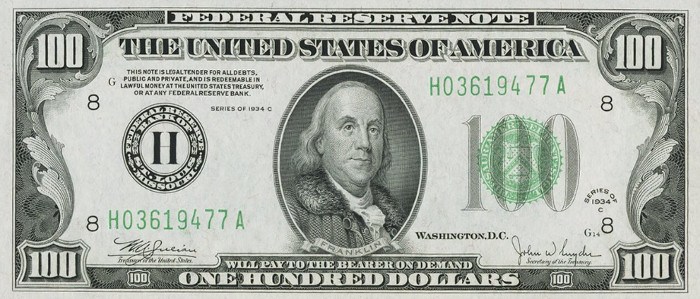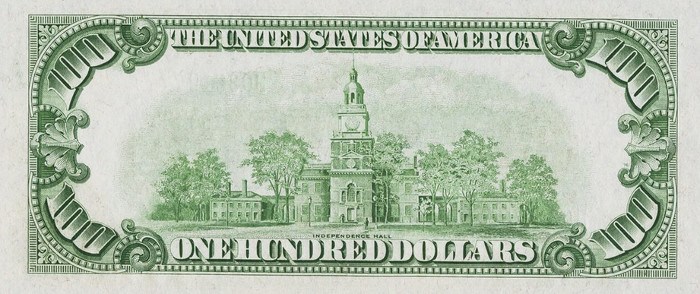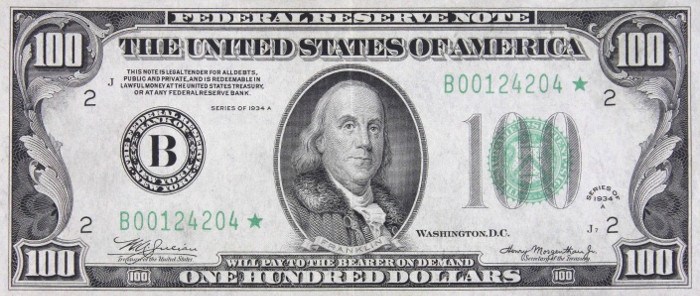The 1934 five dollar silver certificates can be valuable depending on the series and condition. Keep reading to learn more about these notes.
These Federal Reserve notes have green seals. They were signed by W.A. Julian and Henry Morgenthau Jr. At the time Julian was Treasurer of The United States and Morgenthau Jr. was the Secretary of the Treasury.


Specifications
| Denomination: | $100.00 USD |
| Type: | Federal Reserve Note |
| Portrait: | Benjamin Franklin |
| Series: | Five: 1934, 1934A, 1934B, 1934C, 1934D |
Value
Condition plays a large role in the value of these bills. Most circulated bills will only be worth their face value of $100. Notes in very fine condition and up will sell for a premium above their face value. In addition, the series plays a large role in the value. There are the standard series notes and then there are the more valuable star note series. In this section we will examine the values for the standard series notes.
Most 1934 series notes are worth around $145 in very fine condition. In extremely fine condition the value is around $175. In uncirculated condition the price is around $250-325 for bills with an MS 63 grade. Notes issued from the Federal Reserve Bank of Minneapolis are more valuable in uncirculated condition. Each of those notes is valued at around $600 in uncirculated condition.
The 1934A series notes are worth around $135 in very fine condition. In extremely fine condition the value is around $155. In uncirculated condition the price is around $200-275 for notes with an MS 63 grade.
The 1934B series notes are worth around $150 in very fine condition. In extremely fine condition the value is around $180. In uncirculated condition the price is around $325 for bills with an MS 63 grade.
Most 1934C series notes are worth around $150 in very fine condition. In extremely fine condition the value is around $175. In uncirculated condition the price is around $250-350 for notes with an MS 63 grade. Notes issued from the Federal Reserve Banks of Boston and New York are more rare and more valuable.
Most 1934D series notes are worth around $200-275 in very fine condition. In extremely fine condition the value is around $350-375. In uncirculated condition the price is around $450-600 for bills with an MS 63 grade. Notes issued from the Federal Reserve Bank of Dallas are more valuable in uncirculated condition. Each note is valued at around $900 in uncirculated condition.
Low Serial Number Bills
Low serial number bills are more valuable. If your bill starts with 6 or 7 zeros then it will command a premium. In addition there are star notes that can be even more valuable. Keep reading to learn more about star notes.
Star Notes

If you have a bill that has a star before the serial number then it's known as a 'star note'. These bills are overprint notes that are more rare and more valuable.
Most 1934 series star notes are worth around $225 in very fine condition. In extremely fine condition the value is around $450. In uncirculated condition the price is around $1,250-1,650 for notes with an MS 63 grade. Notes issued from the Federal Reserve Banks of Dallas and San Francisco are more valuable in very fine and extremely fine condition.
Most 1934A series star notes are worth around $250-265 in very fine condition. In extremely fine condition the value is around $325-350. In uncirculated condition the price is around $750-1,000 for notes with an MS 63 grade.
Most 1934B series star notes are worth around $775 in very fine condition. In extremely fine condition the value is around $1,250-1,375. In uncirculated condition the price is around $3,250 for notes with an MS 63 grade. Notes issued from the Federal Reserve Bank of Atlanta are more valuable.
Most 1934C series star notes are worth around $700-850 in very fine condition. In extremely fine condition the value is around $1,350-1,625. In uncirculated condition the price is around $3,375 for notes with an MS 63 grade. Notes issued from the Federal Reserve Bank of Dallas are more valuable. They sell for about double the value of the other 1934C series star notes.
Most 1934D series star notes are worth around $1,625-1,800 in very fine condition. In extremely fine condition the value is around $2,900-3,000. In uncirculated condition the price is around $5,000 for notes with an MS 63 grade. Notes issued from the Federal Reserve Bank of Chicago are worth less money.
If you have a star note then it's best to keep it secure in a protective currency holder and get it examined by a currency expert.
Grading System
Very fine- A note that has been in circulation but not for a long time. The note is still relatively crisp. There may be some creases, folds, or light smudges.
Extremely fine- A note that shows small signs of having been in circulation. The note will be bright and it will have almost all of its original crispness. There might be one or two minor creases or folds but there are no stains, discolorations, or tears.
MS 63 choice uncirculated- A note that shows no signs of ever having been in circulation. The note still has its original crispness. The note is also well-centered.
History of $100 Dollar Bills
The one-hundred dollar bill was first issued in 1862, and early bills consisted of legal tender notes, silver certificates, and gold certificates. The first Federal Reserve note was issued in 1914. Benjamin Franklin is the face of the 100 dollar bill but some of the earlier series featured other historical figures such as Abraham Lincoln and James Monroe.
Many of the older one-hundred dollar bills are quite valuable even in fair condition. The prices range from hundreds of dollars to tens of thousands of dollars- it all depends on the series and variety. However most one-hundred dollar bills printed after 1929 are not valuable. This is because they are neither rare nor sought after by collectors.
The $100 dollar bill is the highest-denomination bill that is currently in circulation. However it wasn't the highest-denomination bill ever printed by the US government. There used to be 500 dollar bills, 1000 dollar bills, 5000 dollar bills, and even 10,000 dollar bills in circulation. Those bills were rarely ever used and today they are completely out of circulation.
Sources:
A Guide Book of United States Paper Money
See also:
1950 100 Dollar Bill 1929 100 Dollar Bill 1928 100 Dollar Bill
